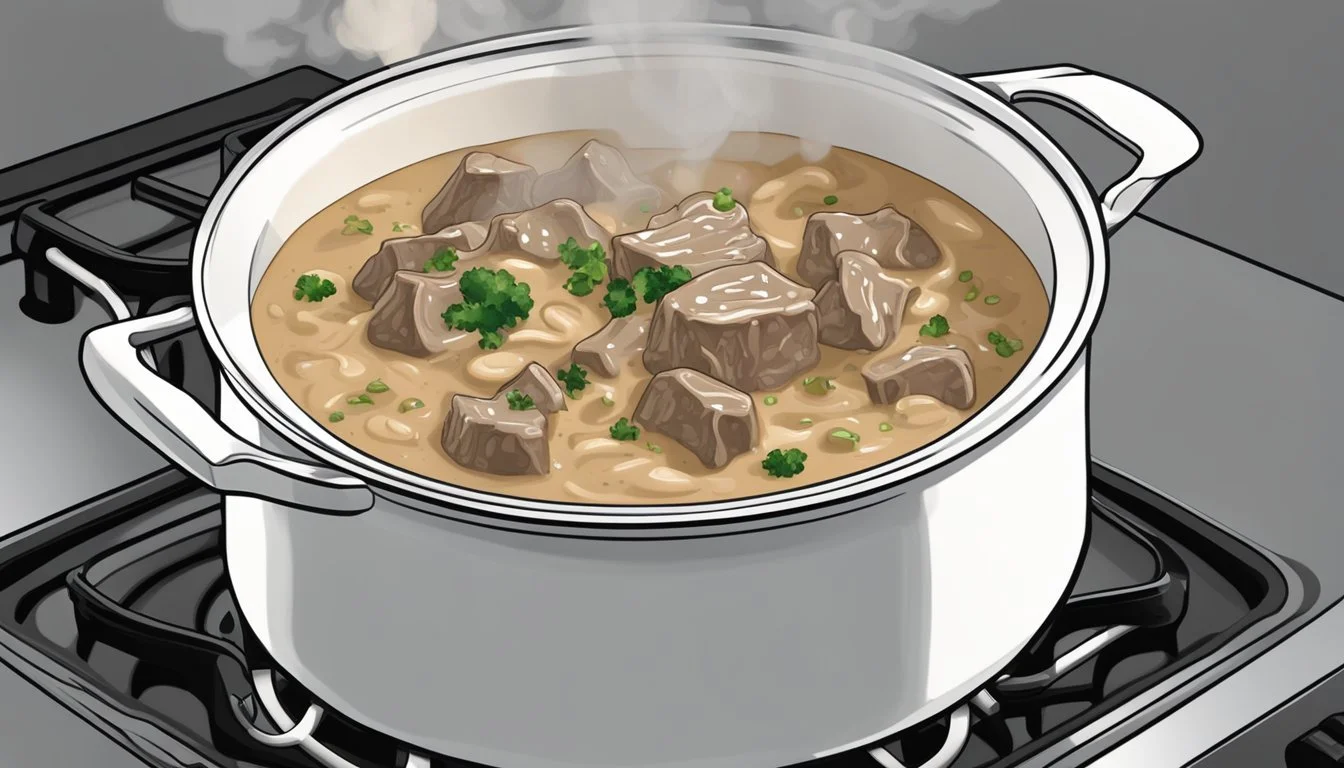How Long Does Gluten-Free Beef Stroganoff Last?
Storage Tips and Guidelines
Understanding how long gluten-free beef stroganoff lasts can save you from unnecessary food waste and ensure you enjoy your meal safely. When stored properly in an airtight container in the refrigerator, gluten-free beef stroganoff can last up to 3-4 days. This timeframe keeps the dish fresh while retaining its flavor and texture.
Temperature plays a crucial role in maintaining the quality of your stroganoff. Keeping it refrigerated at 40°F (4°C) or below is essential. For those looking to extend its shelf life, freezing is a viable option. Properly frozen, gluten-free beef stroganoff can last for about 2-3 months, making it a great make-ahead meal.
By following these storage tips, you can maximize the longevity of your gluten-free beef stroganoff and always have a delicious meal ready to enjoy.
Understanding Gluten-Free Beef Stroganoff
Gluten-free beef stroganoff is a comforting and delicious variation of the traditional beef stroganoff dish. Made without gluten-containing ingredients, it caters to those with celiac disease or gluten intolerance.
This dish typically includes beef, mushrooms, onions, and a rich creamy sauce. Replacing gluten-containing components like flour with gluten-free alternatives ensures the dish remains safe for gluten-sensitive individuals.
Key Ingredients
Beef: Commonly, tender cuts such as sirloin or tenderloin are used.
Mushrooms: Enhances the flavor and provides a hearty texture.
Onions and Garlic: Adds depth and aromatic qualities.
Gluten-Free Flour: Used to thicken the sauce without gluten.
Dairy-Free Options: Can be used for those who are also lactose intolerant.
Spices: Commonly, smoked paprika, mustard, and pepper are included for seasoning.
Cooking Method
Searing the Beef: Cooking the beef in a hot skillet creates a flavorful crust.
Sautéing Vegetables: Onions, garlic, and mushrooms are cooked to release their flavors.
Making the Sauce: The combination of gluten-free flour, broth, and cream or dairy-free alternatives.
Simmering: Incorporating all ingredients and simmering for a few minutes to meld the flavors.
Dietary Benefits
Gluten-Free: Safe for individuals with celiac disease.
Adaptable: Easily made dairy-free for those with lactose intolerance.
Comforting: Offers the same heartwarming qualities as the traditional dish.
These elements make gluten-free beef stroganoff both appealing and accessible to a wide range of dietary needs.
Key Ingredients for Gluten-Free Beef Stroganoff
Creating gluten-free beef stroganoff requires careful selection of ingredients to ensure both flavor and dietary needs are met. The following subsections detail the essential components, including meat selection, gluten-free elements, and both dairy and dairy-free alternatives.
Meat Selection
Choosing the right meat is crucial for a flavorful stroganoff. Beef tenderloin, sirloin, or steak cuts are ideal because they are tender and cook quickly. Ground beef can also be used for a different texture and ease of cooking.
Properly seasoned with salt and pepper, the meat should be seared in olive oil or another preferred oil to lock in juices. Ensure the meat is cut into bite-sized pieces to aid in even cooking and better integration with other ingredients.
Gluten-Free Elements
Integrating gluten-free elements is fundamental to this recipe. Gluten-free flour serves as a thickener for the sauce. It can be substituted with cornstarch if necessary, offering a similar consistency without gluten.
For pasta, choose gluten-free noodles or gluten-free pasta, as these provide a stable base for the stroganoff sauce. Ensure the pasta is cooked to al dente to hold up well within the dish.
Beef broth or beef stock should be checked to confirm they are gluten-free, providing the foundational flavor for the sauce.
Dairy and Dairy-Free Alternatives
The creamy aspect of beef stroganoff can be achieved using various dairy products, such as sour cream, heavy cream, cream of mushroom soup, or cream cheese. These ingredients create a rich, smooth sauce that complements the beef and vegetables.
For those avoiding dairy, coconut cream or plain Greek yogurt offers suitable substitutes, ensuring the sauce remains creamy and flavorful. Dairy-free sour cream is another excellent option for those with dairy restrictions, maintaining the dish's traditional texture.
Use fresh mushrooms, onions, and garlic to add depth and richness, frying them in the remaining oil or butter until softened and fragrant. This foundation complements the dish's saucy elements and enhances the overall dining experience.
Step-by-Step Cooking Instructions
Gluten-free beef stroganoff can be easily prepared with the right techniques and ingredients. These instructions guide you through preparation and cooking to create a delicious and gluten-free meal.
Preparation Techniques
Select Quality Ingredients: Choose fresh, high-quality beef sirloin, mushrooms, and onions. Having the best ingredients ensures better flavor and texture.
Prep the Beef: Freeze the beef for about 10 minutes to make slicing easier. After freezing, slice the beef into thin strips. Pat dry and season with salt and pepper.
Prep Other Ingredients: Slice the mushrooms and onions. Mince the garlic. Prepare the gluten-free flour or any thickening agent you prefer, such as cornstarch.
Gather Equipment: Ensure you have a large skillet or cast iron pan. If using an instant pot, ensure it is ready.
Substitutions and Gluten-Free Options: Use gluten-free flour and, if needed, dairy-free sour cream or coconut cream as substitutes.
Cooking Process Overview
Searing the Beef: Heat oil in a large skillet over medium-high heat. Add the beef strips and sear for 2-3 minutes on each side. Remove from the pan and set aside.
Cooking the Vegetables: In the same skillet, add butter or more oil. Add sliced mushrooms, onions, and garlic. Sauté for about 7 minutes until they soften.
Making the Sauce: Add gluten-free flour to the vegetables and mix well. Pour in beef broth and dry white wine if using. Add dijon mustard and paprika for extra flavor. Bring to a boil.
Combining Ingredients: Return the beef to the skillet. Add dairy-free sour cream if needed. Stir and let the mixture simmer on low heat for 10 minutes. Cover the skillet with a lid to ensure even cooking.
Final Touches: If the sauce is too thick, add more broth or water. Adjust seasoning with salt and pepper. Garnish with fresh parsley or chives before serving.
Proper Storage and Shelf Life
Understanding the best practices for storing gluten-free beef stroganoff ensures its quality and safety. The following guidelines cover how to properly refrigerate and freeze this classic comfort food.
Refrigeration Guidelines
Gluten-free beef stroganoff can last 3-4 days in the refrigerator.
To maximize shelf life, store the dish in an airtight container immediately after cooking. Allow it to cool to room temperature before refrigeration to prevent condensation, which can lead to bacterial growth. The fridge should be set to 40°F (4°C) or lower to keep the stroganoff at a safe temperature.
When reheating, transfer the desired portion to a microwave-safe dish or stovetop pan and heat until it reaches an internal temperature of 165°F (74°C).
Freezing and Reheating Tips
For longer storage, freeze the beef stroganoff in a freezer-safe container or heavy-duty freezer bag.
Ensure it is well-sealed to prevent freezer burn. The dish can last up to 3 months in the freezer.
When ready to consume, thaw it in the refrigerator overnight. For faster thawing, use the microwave's defrost setting, but ensure not to partially cook the dish during thawing.
Reheat thoroughly on the stovetop or microwave until it reaches an internal temperature of 165°F (74°C) before serving. Always stir well to ensure even heating.
Serving Suggestions
Gluten-free beef stroganoff can be paired with various side dishes and presented beautifully for a complete dining experience. Consider the following accompaniments and presentation ideas to make the meal more enjoyable.
Accompaniments Options
Beef stroganoff pairs well with diverse sides. Consider serving it over gluten-free egg noodles, ensuring a traditional feel while staying safe for those with gluten sensitivities. As an alternative, Jovial gluten-free egg noodles or rice options like jasmine or basmati provide a mild base that complements the rich flavors of the stroganoff.
Mashed potatoes or cauliflower rice offer hearty and low-carb choices. The creamy texture of mashed potatoes contrasts pleasantly with the stroganoff sauce, while cauliflower rice maintains a lighter profile. Options like green beans or steamed peas add a fresh touch, balancing the heavy components of the main course.
Presentation Tips
To enhance the visual appeal, consider serving the stroganoff on wide, shallow bowls or large plates that provide ample space for both the sauce and the accompaniments. Arrange the sides—noodles, rice, or potatoes—neatly before ladling the beef stroganoff on top or nearby.
Garnishing can elevate the dish’s presentation. Use fresh parsley or chopped chives to add a pop of color. For additional flair, a few slices of mushrooms or a drizzle of sour cream can be artistic touches. Presenting the stroganoff with a salad on a separate plate can also create a well-rounded dinner setup.
By paying attention to these details, your gluten-free beef stroganoff will not only taste delicious but also look appetizing, creating a complete dining experience.
Nutritional Information
When considering the nutritional profile of gluten-free beef stroganoff, it's essential to look at the calorie content and the balance of macronutrients and micronutrients.
Analyzing Calorie Content
Gluten-free beef stroganoff typically ranges from 350-500 calories per serving. The exact calorie count depends on the specific ingredients and quantities used.
Beef: Generally provides 150-200 calories per serving.
Cream or dairy-free substitutes: Contribute about 100-150 calories.
Mushrooms, onions, and other vegetables: Add approximately 30-50 calories.
The calorie content may vary if alcohol or additional fats like butter are included.
Understanding Macros and Micros
Macronutrients in gluten-free beef stroganoff include proteins, fats, and carbohydrates.
Proteins: Beef is rich in protein, offering around 20-25 grams per serving.
Fats: Depending on the ingredients, fats can range between 15-25 grams. Using butter or oil will affect this value.
Carbohydrates: With the addition of gluten-free flour and vegetables, expect around 10-15 grams of carbs.
Micronutrients vary but typically include:
Vitamins: B vitamins from beef, Vitamin D from mushrooms.
Minerals: Iron, zinc, and potassium mainly from beef and vegetables.
Balancing these nutrients ensures a healthy and nutritious meal.
Tips for Perfect Gluten-Free Beef Stroganoff
For a great gluten-free beef stroganoff, it's essential to choose the right cut of meat and achieve the perfect sauce consistency. These key points ensure that your dish is both flavorful and enjoyable.
Choosing the Right Cut of Meat
Selecting the best cut of meat is crucial. Beef tenderloin or high-quality sirloin steak are excellent choices due to their tenderness and flavor. Using tougher cuts can result in a chewy dish, which is undesirable.
Always trim excess fat and slice the beef into thin, even strips. This ensures quick, even cooking and allows for better absorption of flavors. Labor spent on precision pays off with tender and juicy results.
Cooking time matters. Sear the beef at a medium-high heat for about 3-4 minutes on each side to achieve a nice crust while keeping the inside tender. Avoid overcooking, as this can make the beef tough.
Achieving the Ideal Sauce Consistency
The sauce is the heart of any stroganoff. Use a mix of broth, cream, and gluten-free flour or cornstarch to achieve the desired thickness. Frying mushrooms, onions, and garlic first helps to build a robust base of flavors.
Balance the consistency by adjusting the amount of thickening agent. For a thicker sauce, combine ¼ cup water with 1 tablespoon cornstarch to create a slurry, then whisk it into the boiling sauce.
Simmering techniques are key. Reduce the heat to low and let the sauce simmer for at least 10 minutes. This process melds the flavors and allows the sauce to thicken naturally. Stir frequently to avoid lumps and ensure even thickening.
Maintaining the right heat settings prevents the cream from curdling. Keeping it on low heat when adding dairy products helps maintain a smooth, creamy texture essential for an authentic stroganoff experience.
Common mistakes involve not tasting and adjusting the seasonings. Always taste and tweak the salt, pepper, and other spices to ensure the sauce complements the other elements perfectly.






